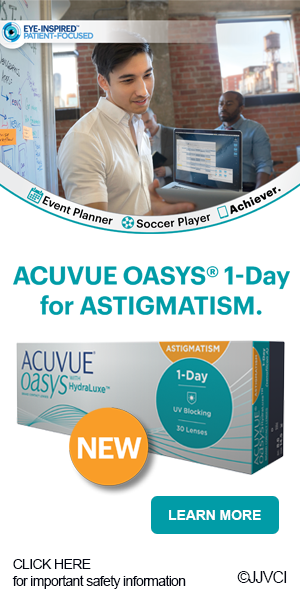Joey, a 5-year-old Asian male, came into the office today. He has been seeing me (Dr. Kading) every year starting with his InfantSEE exam. Joey’s mom and dad are at –7.00D and –4.50D, respectively. Additionally, his maternal grandmother had a retinal detachment last year that is believed to have resulted from her pathological myopia. Because both parents have myopia, he has a high risk of developing myopia. Joey is the youngest of four kids, and all of his siblings have been doing myopia management for several years. For Joey, the writing is pretty much on the wall.
Six months ago, Joey had a cycloplegic refraction of –0.25D OD and OS. This refractive outcome has seemed OK for much of my career, but recently I hate seeing this refractive error in a 4-year-old. Personally, I like to see a kiddo landing on emmetropia between 6 to 8 years old, so knowing that Joey was getting there in five years gave me pause. Like all of my pediatric patients who have myopia, I asked his parents to bring him back to my office in six months for another cycloplegic exam. Joey’s parents know exactly why I am being so cautious; being progressive with myopes is my new normal. Because Joey has nearly every genetic risk factor, his development of myopia is pretty much a foregone conclusion. And, his cycloplegic refraction today revealed a –0.25D correction.
Transitioning into Myopia
This raises an important question: What do we do with low myopes who have just transitioned into myopia? Should we wait until they progress to a larger amount of myopia before we initiate treatment, or do we do so now?
All of our myopia management treatments have benefits and drawbacks for this population. Soft multifocals provide a strong plus power and stimulus upon the peripheral retina. However, multifocals could be a challenge, especially because Joey does not yet have much of a refractive error to correct. Orthokeratology lenses are usually our go-to solution for young children so that the parents can take on the lens handling. But again, Joey only has a small prescription. Atropine means that he will be putting medication in his eye everyday, which I do not like. But, for a super-low myope, it seems to be the best option.
Knowing that Joey is going to be a myope for the rest of his life makes me want to start treatment now while it is early. We discussed the drawbacks and benefits with his parents and elected to initiate atropine 0.05%. At his two-week follow up, we will see how he has adapted and whether there was any substantial effect on his accommodation. We educated his parents to never stop the medication abruptly without speaking to us first to avoid a rebound effect. And, if he progresses further in his myopia, we will consider adding a contact lens option to his myopia therapy.
The Verdict
Are you progressive or passive with myopia management in the early stages? If being progressive is the new normal, then count us in. CLS
Read more: https://www.clspectrum.com/issues/2020/january-2020/is-this-the-new-norm





